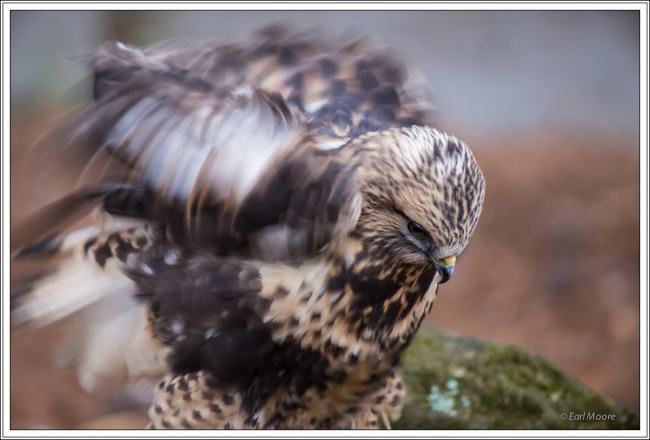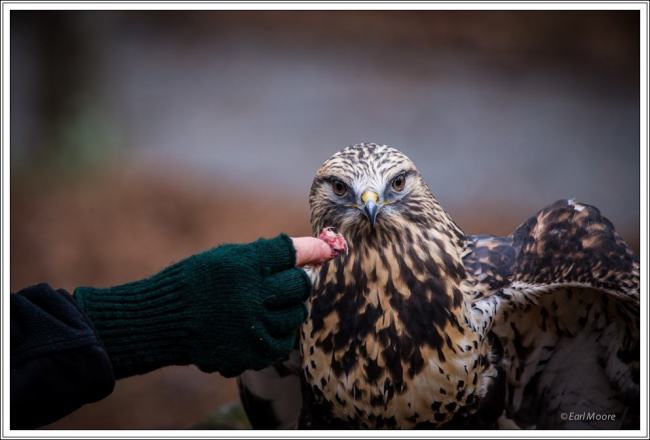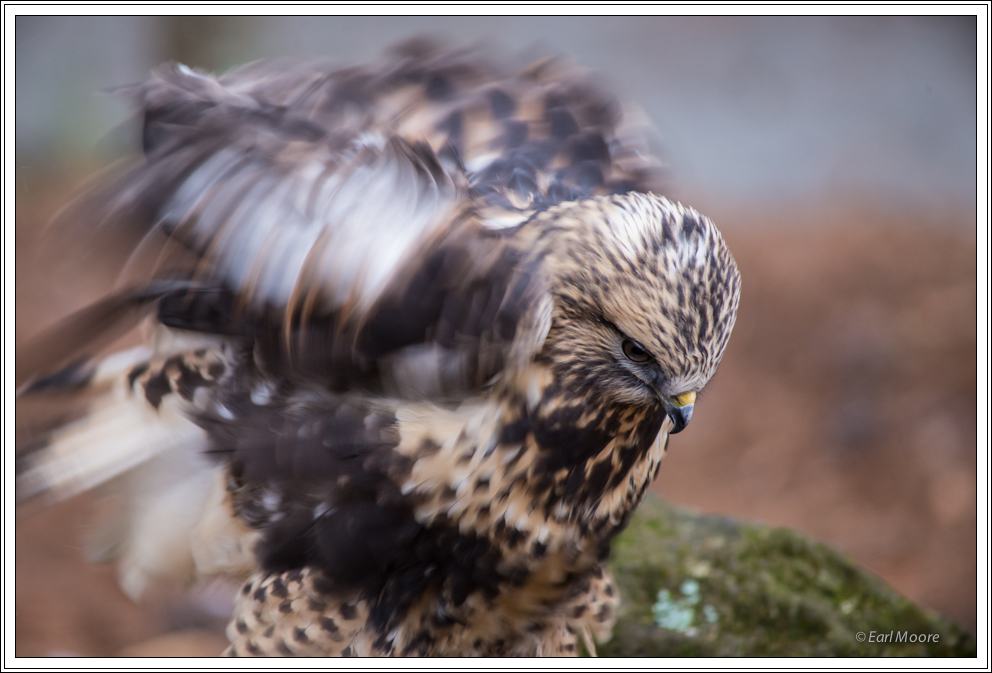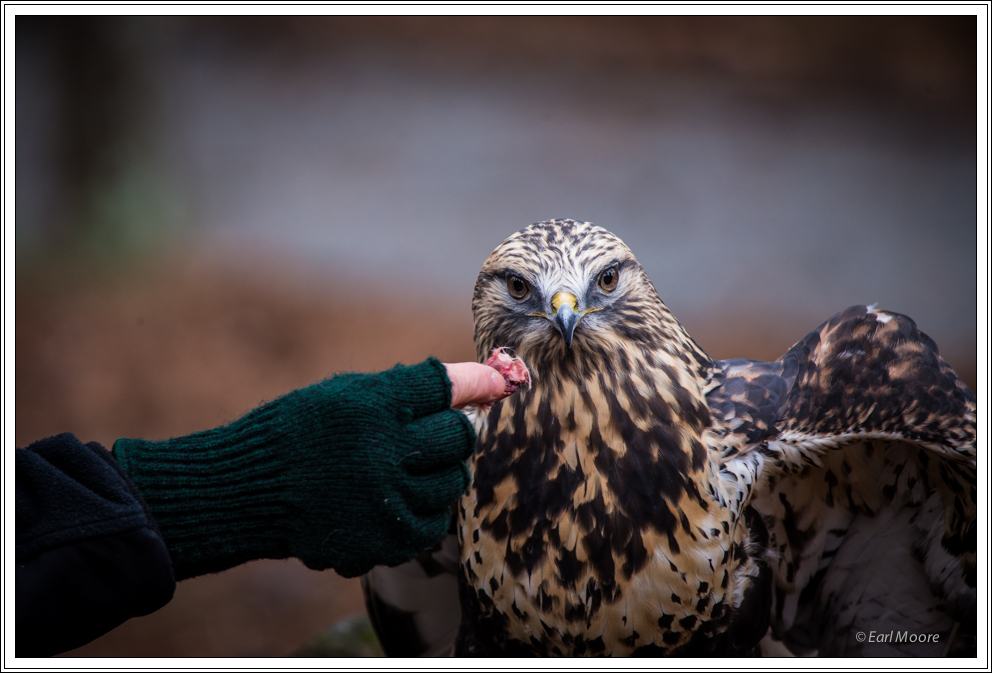Aletta – Rough-Legged Hawk, “Shake a little insulating air into my wings”
Photographing “birds of prey” during an event like PhotoWILD, Carolina Raptor Center, might seem like “shooting sitting ducks” (easy targets), and it may be compared to photographing them in the wild, which I have no experience with, but there’s still a bit of challenge to it as I’m still discovering after two such events.
My good to bad photo ratio from the latest event was very similar to what Tom Dills reported in his blog post covering the PhotoWILD we both attended this past Saturday (23rd March.) My camera gear consisted of a Nikon D600 and a Tamron 200-500mm f/5-6.3 lens. I shot mostly on continuous slow and a few time continuous high (flight photo attempts) burst mode.
Five hours of the event resulted in a little over 1200 shots. My first filtering pass was based simply on the focus being “acceptable” — “acceptable” being defined as a very sharp focus on the eyes of these beautiful birds. Sounds simple but shooting at 500mm f/6.3* at 20 feet distance gives about one inch depth of field (DOF), about equal to many of their beaks. Only 400 of the original 1200 images made the first pass.
Aletta – Rough-Legged Hawk, “Only the mouse bits, please”
My second filtering pass was to eliminate those that were near duplicates (remember, burst mode shooting) and those that were not acceptable compositions, the what was I thinking when I shot that images — about 50 images made the second pass.
Of those 50 I’ll probably process less then 12-20 of them because many while good enough photos don’t exhibit, to my mind, any special qualities.
So there you have it, no more then a 60:1 unacceptable to acceptable photo ratio. Perhaps not much worst then casual walk-about nature photography but remember, this was while shooting “sitting ducks” from a tripod. ;-)
* Shooting Conditions: cloudy with low flat light requiring high ISO numbers and maximun Aperture settings in pursue of fast shutter speed.
Discover more from Meandering Passage
Subscribe to get the latest posts sent to your email.





Given that you were shooting a lot of burst modes, with shallow depths of fields I’d say 60:1 ain’t bad. How do you like your D600? I’m thinking seriously about jumping on the FX bandwagon…
John, thanks!
The image quality and build quality on the D600 is top notch. After shooting a D700 for several years I’ve found some of the controls they changed taking a little time to get use to…especially those concerning autofocus. The smaller and nearer to center of view field autofocus points (39 vs. 51 on the D700/D800) also has come into play on a couple of occasions. I wouldn’t recommend it for action or sports use but for nature and landscape it works mighty well. But the more I use it the more I become comfortable with it. Coming from a D7000 you might not have as many issues with the changes.
Lovely bird portraits, it doesn’t matter how or where you took them, the birds are still beautiful animals. Very nice photographs.
Hi Tony, Thanks for stopping by and the comment!
Yes, 60:1 might sound not too successful, but this is *your* set of rules for the test – many others might be much less critical. But extending one’s reach into new realms, risks become unavoidable – and in the end not only the keepers but also the learning effect is success. I for my part like the muted light here – there’s not so much challenge in photographing in bright, sunny light, but the risk of less interesting results.
Markus, thanks. You’re right the ratio is determined by each photographers on criteria for determining an acceptable or unacceptable photo. I’m fairly tough on my own photos…probably more so then I would be with someone else.
Even this second time around it continues to be a fun learning experience.
Earl, I think you’re seeing a lot of what I found, that just because a photograph is technically good doesn’t make it aesthetically good. Only a few of the “sharp” photographs show the expression or the gesture that we looked for.
I took over 200 shots of Aletta, and only 4 made my initial cut. Like you, many just weren’t as sharp as I wanted, but mostly they just didn’t have the expression I was going for.
Mostly, I’m glad that – so far at least – we’ve come up with the same names for the same birds! I was getting a little confused as I captioned them all, but think I finally got the right names with the right birds. Or at least we agree with each other! :)
Tom, I think you’re exactly right. This second time around I was essentially looking for something beyond the standard “bird portrait” — something that told a story or showed some of the personality of the bird or it’s interaction with the handlers, photographers or it’s environment. I not so sure how successful I was in this endeavor.
On the bird names…I’m hoping you and Paul got them right so I could follow your examples. :-)
I think many pros might agree 60:1 is an acceptable ratio. Given that the D600 is full frame, I wonder if the Oly (with a similar telephoto lens) might produce greater depth, given the smaller sensor. But, all in all, and judging from the photos you posted, I’d say that this was a very successful outing since it produced some outstanding photos.
Ken, At first 60:1 seemed a low ratio but after I thought about it, it’s not terribly bad. The Oly might in fact product a greater DOF but then you’d loose some of the artistic effects — never satisfied! :-)
Thanks so much!